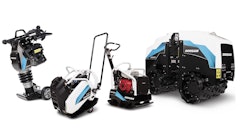When compacting a trench, there’s no reason for you to put an employee in harm’s way. Trench compactor manufacturers offer a variety of remote options that allow you to keep your people safely above the surface.
In addition to the advantages of keeping a worker out of the trench, there are a few other safety and operator comfort elements to consider.
“It’s good to have a remote that allows you to be outside the trench for noise reduction and vibration reduction,” says Todd Rozar, southeast district sales manager at Dynapac. “I would say that the manual controls should be used in the short term, for example, when loading.”
Dynapac has engineered a few operator comfort features into its LP 8500 trench compactor for situations where an operator must run the machine manually. Toggle switches are mounted on rubber grommets, which keep the operator stand from vibrating.
Ingersoll-Rand Co. has a similar opinion of manual controls, going as far as to make the manual setting on its TC-13 trench compactor strictly for moving. In order to use the vibration mode, the operator has to be controlling the machine via the remote.
“When in working mode, the TC-13 is designed to be operated remotely with any one of the three available remote controls,” says Mickey Benedict, product marketing manager at Ingersoll-Rand. “Manual operation only allows movement of the unit, but not with the vibration engaged.”
The TC-13 comes standard with a radio remote control. A joystick remote with umbilical cord or a joystick radio remote are other available options.
Available remote control options
Umbilical cord remotes are common in the industry. For example, the Bomag BMP851 multipurpose compactor comes standard with the umbilical cord and manual controls, with radio and infrared options available.
Mark Lee, owner of Mark Lee Construction, Alexandria, MN, uses two of these units for various trenching projects, including backfilling around footings and in sewer and water line trenches. He likes the multipurpose compactors because they are easier on his operators and less expensive to run than the rammers he has used in the past.
Lee went with umbilical cord remotes on his models for safety reasons. “I wanted this style to keep the operator with the machine — to keep him watching the machine,” Lee says. “Otherwise, he might start drifting off, and things could happen when people aren’t paying close attention.”
There are a few downsides to the umbilical remote, namely the chance that the cord could get caught on obstacles, run over on the jobsite or pulled farther than the length it was made to extend.
“One of the biggest problems with umbilical cord control machines — regardless of the make — is no matter how long you make that cord, they’re going to stretch it further than what it was designed for,” says Peter Price, product manager at Bomag Light Equipment. Price adds that he would recommend radio remote configurations over the umbilical and infrared systems to most customers.
Infrared systems uses the same basic technology used in television remote controls. However, a line of site is needed between the remote and the machine for operation, and the signal can sometimes be disrupted by airborne dirt, a passing truck or UV rays on sunny days.
The remote option that has gained the most popularity in recent years is the radio remote system. Several manufacturers now offer it standard on their machines.
One reason for the radio remote’s rise in popularity is improved technology that has addressed many of the concerns that were applicable in the past. For instance, restrictions around airports and blasting sites have been lifted.
“The FCC monitors those things to make sure there is not interference,” Wenzel says. “The signal these remotes use is in the cell phone frequency, so you can basically use the radio remote anywhere it would be safe to use a cell phone.”
Manufacturers have also shortened the length from which a radio control will work. Today’s remotes will only work generally up to the 100- to 500-ft. range. This has eliminated some of the concerns people had with past remotes that functioned up to a mile away from the machine.
In addition, radio remotes have shrunk in size, to about the same size as a television remote. And they work in real time, whereas infrared remotes may have a small lag period before the machine actually performs the desired function.
Stone has embraced the recent improvements in radio remote technology, making it the only remote option available with its Bulldog Trench Roller. From there, the company has gone a step beyond, incorporating a maintenance feature into its radio remote.
“We have diagnostic lights on the transmitter and the radio that allow you to see how the machine is operating and what circuits are working,” Wenzel says. “What we teach our customers to use it for is preventive maintenance.”


























